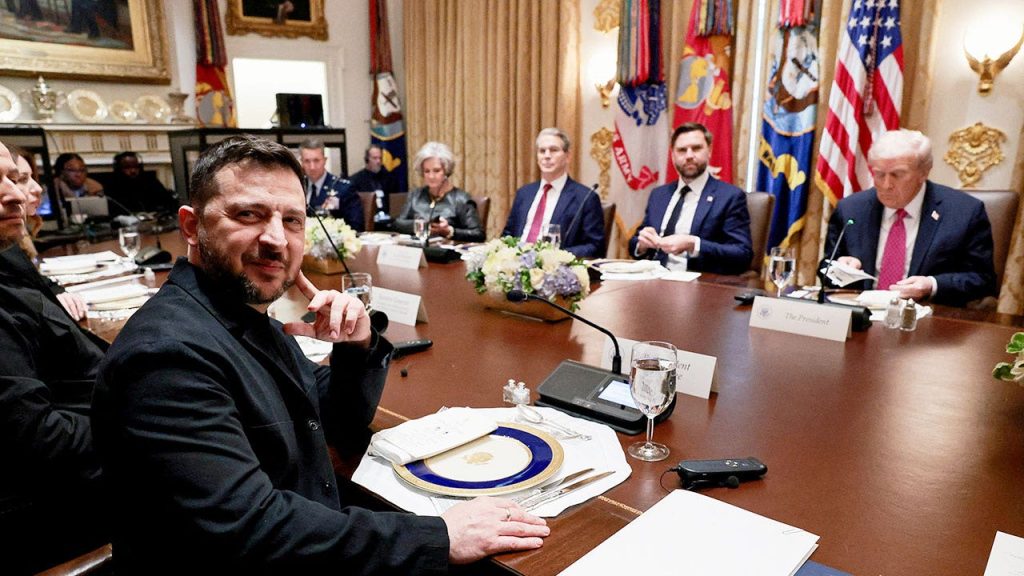Ukraine and the U.S.: Negotiating Weapons Exchange amid Ongoing Conflict
In a compelling diplomatic overture, Ukrainian President Volodymyr Zelenskyy proposed a strategic exchange with U.S. President Donald Trump during their recent meeting. The proposition involves trading Ukraine’s drone capabilities for American high-precision long-range Tomahawk missiles, highlighting the evolving nature of modern warfare technology. Zelenskyy emphasized that successful military campaigns in today’s technological battlefield require diverse capabilities rather than singular solutions. “If you want to target a military goal, you need thousands of drones,” Zelenskyy explained, underscoring Ukraine’s current drone arsenal while pointing out their critical need for advanced missile systems like the Tomahawk. This exchange proposal represents a potential pathway for deepening U.S.-Ukraine military cooperation amid the ongoing conflict with Russia, while also acknowledging the complementary military strengths each nation possesses.
Trump’s response to the Ukrainian leader’s proposal demonstrated cautious interest, acknowledging America’s significant drone capabilities while recognizing the serious implications of providing Ukraine with sophisticated long-range missiles. “We have a lot of drones right now. We build our own drones, but we also buy drones from others, and they make very good drones,” Trump noted. When directly asked about his interest in such an arrangement, Trump affirmed, “Yeah, we would.” However, his comments revealed the complex calculations involved in such decisions, as he characterized providing Tomahawks as “a big deal” that would constitute an “escalation” in the conflict. This measured response reflects the delicate balance American leadership must maintain between supporting Ukraine’s defense needs and avoiding actions that could significantly expand the war’s scope and intensity.
The potential weapons exchange takes place against the backdrop of evolving diplomatic maneuvers involving multiple world powers. Trump and Russian President Vladimir Putin have agreed to meet in person in Hungary, though no specific date has been set for this high-stakes discussion. Notably, Zelenskyy is not expected to participate in this meeting, raising questions about how Ukraine’s interests will be represented in any discussions about the war’s resolution. Trump’s stated preference for seeing an end to the conflict suggests he may be pursuing diplomatic pathways alongside potential military assistance, though the specifics of any peace framework remain unclear. This diplomatic dance highlights how weapon transfers are not merely technical decisions but deeply political ones embedded in broader strategic relationships and objectives.
The Tomahawk missile represents a significant potential capability upgrade for Ukrainian forces. These sophisticated long-range weapons could theoretically strike targets deep within Russian territory, even reaching beyond Moscow. Such capability would fundamentally alter the strategic calculus of the conflict, potentially giving Ukraine leverage by threatening previously secure Russian military assets and infrastructure. However, Trump expressed reservation about immediately providing such weapons, noting his “obligation” to ensure American defensive needs remain fully met. “Because you never know what’s going to happen in war and peace, right? You never know what’s going to happen,” Trump observed, highlighting the unpredictability of international conflicts and the need to maintain robust American military readiness regardless of support provided to allies.
Zelenskyy’s proposal reflects Ukraine’s evolving military strategy as the war continues. By highlighting Ukraine’s drone capabilities, he’s emphasizing one of the areas where Ukrainian forces have demonstrated remarkable innovation and effectiveness. Ukrainian drones have become a signature element of their military response, from modified commercial drones dropping small munitions to sophisticated surveillance platforms and maritime drone attacks against Russian naval assets in the Black Sea. The offer to share this technology and expertise with the United States represents both a practical exchange proposal and a symbolic statement about Ukraine’s contributions to modern warfare knowledge. It positions Ukraine not merely as a recipient of aid but as a valuable partner with unique capabilities worth American investment and support.
The discussions between Trump and Zelenskyy illustrate the complex intersection of military necessity, diplomatic maneuvering, and strategic calculation that defines international relations during wartime. While no immediate agreement on Tomahawk missiles emerged from their meeting, the dialogue itself reflects the continuing importance of U.S.-Ukraine relations as the conflict persists. For Ukraine, securing advanced weapons systems remains crucial to their defense strategy and negotiating position. For the United States, decisions about weapons transfers must balance support for an ally under attack with considerations about escalation risks and broader geopolitical implications. As Trump pursues meetings with Putin while simultaneously discussing weapons exchanges with Zelenskyy, the coming months may prove decisive in determining not just the weapons Ukraine receives, but the broader trajectory of the war and potential pathways to its resolution.


